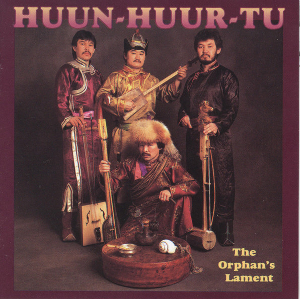
Overtone singing, also known as overtone chanting, harmonic singing, polyphonic overtone singing, or diphonic singing, is a set of singing techniques in which the vocalist manipulates the resonances of the vocal tract to arouse the perception of additional separate notes beyond the fundamental frequency that is being produced.
Traditional Inuit music, the music of the Inuit, Yupik, and Iñupiat, has been based on drums used in dance music as far back as can be known, and a vocal style called katajjaq has become of interest in Canada and abroad.

The Tuvans or Tyvans are a Turkic ethnic group indigenous to Siberia who live in Russia (Tuva), Mongolia, and China. They speak Tuvan, a Siberian Turkic language. In Mongolia they are regarded as one of the Uriankhai people groups.
Tuva is a part of Russia, inhabited by a Turkic people. Tuvans are known abroad for khoomei (xöömej), a kind of overtone singing.

Huun-Huur-Tu are a music group from Tuva, a Russian federative republic situated on the Mongolia–Russia border. Their music includes throat singing, in which the singers sing both a note and its overtones, thus producing two or three notes simultaneously. The overtone may sound like a flute, whistle or bird, but is solely a product of the human voice.

Sainkho Namtchylak is a singer originally from Tuva, an autonomous republic in the Russian Federation just north of Mongolia. She is known for her Tuvan throat singing or Khöömei.

Robert David "Lu" Edmonds is an English rock and folk musician. He is currently, as of 2018, a vocalist and saz and cümbüş player in the Mekons and the guitarist for Public Image Ltd. Edmonds reportedly plays electric guitar, bass guitar, keyboards, bouzouki, saz, cümbüs, oud, and drums, among other instruments.

Yat-Kha is a band from Tuva, led by vocalist/guitarist Albert Kuvezin. Their music is a mixture of Tuvan traditional music and rock, featuring Kuvezin's distinctive kargyraa throat singing style, the kanzat kargyraa.

Albert Budachievich Kuvezin is a Tuvan guitarist and throat singer.

Vihma is Värttinä's 7th album, released in 1998. It is primarily pop- and rock-influenced Finnish folk music. However, three tracks also include Tuvan throat singing.

Chirgilchin, meaning "dance of the air in the heat of the day" or "miracle" in Tuvan, is a group of Tuvan musicians performing traditional Tuvan music. It was established in 1996.
Ethnic electronica is a broad category of electronic music, where artists combine elements of electronic and world music. The music is primarily rooted in local music traditions and regional cultures, rarely relying on global trends of popular music.

Mongol-Tuvan throat singing, the main technique of which is known as khoomei, is a style of singing practiced by people in Tuva and Mongolia. It is noted for including overtone singing. In 2009, it was included in the Representative List of the Intangible Cultural Heritage of Humanity of UNESCO. The term hömey / kömey means throat and larynx in different Turkic languages. That could be borrowed from Mongolian khooloi, which means throat as well, driven from Proto-Mongolian word *koɣul-aj.

Melanie Pappenheim is an English soprano and composer, notable for her vocal work with various British cross-disciplinary composers, with avant-garde theatre companies and on soundtracks.

Aldyn-ool Takashovich Sevek was a master Tuvan throat singer.

Saidash Begzy Oglu Mongush is a Tuvan folk musician from Kyzyl known for his throat singing performance. He is associated with the Tuvan rock band Yat Kha and the folk group Huun Huur Tuu.
Carole Pegg, sometimes Carolanne Pegg, is a British folksinger and fiddle player, and an anthropologist of music (ethnomusicologist).

Soriah is an American overtone singer, performance artist, multi-instrumentalist, and shamanic ritualist headquartered in Portland, Oregon and the Tuvan Republic. His music is a synthesis of traditional forms such as Tuvan throat singing, Shamanic music, Raga, and pre-Columbian Mexica music and language; with avant garde musical styles like Industrial, Ambient, Noise, and Goth. Likewise, his live performance is a fusion of costume and ritual from Tuva, Mexico, North American Native cultures, and Western Ceremonial Magic traditions; as well as chaos magic, butoh, and modern primitive movements of the 20th century. His lyrics, when there are any, are often written in the Nahuatl or traditional Tuvan languages. He won the title of "Best Foreigner" at the 2008 Ustuu-Khuree Festival in Chadanaa Tuva, and in that same year placed as "Third Laureate" at The International Throat Singing Symposium, which remains the highest award given to a non-Tuvan in the history of the Symposium. He also won 2nd Place in the Tuvan Nation Kargyraa Competition in 2014, was given a special award as "Great innovator of the art of Tuvan Throat Singing" in 2016, and won Best Kargyraa Performance at the Khoomei in the Center of Asia Festival 2019. As a solo artist, and with various collaborators and musical ensembles, Soriah has toured throughout the United States, Europe, Asia, and Mexico. He is considered the highest-ranked non-native practitioner of Tuvan throat singing.

The Message is an album by the Guinean-born Canadian musician Alpha Yaya Diallo. It was independently released in Canada in 1998, with an international release in 1999. The Message won a Juno Award for "Best Global Album". Diallo supported the album with a Canadian tour.

The Orphan's Lament is an album by the Tuvan musical group Huun-Huur-Tu. It was released in 1994. The group supported the album with a North American tour.
















